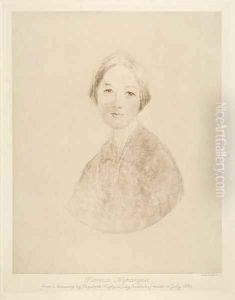Elizabeth Rigby (Lady Eastlake) Paintings
Elizabeth Rigby, later known as Lady Eastlake, was a prominent British art historian, critic, and author in the 19th century. Born on November 17, 1809, in Norwich, England, into a family of intellectuals and artists, she was well-educated from a young age, mastering multiple languages and developing a keen interest in art and literature. Her upbringing in a culturally enriched environment laid the foundation for her later contributions to the art world.
Rigby embarked on extensive travels across Europe, which significantly influenced her perspectives on art and culture. During her travels, she became fluent in German and developed an affinity for German literature and philosophy, which would later inform her critical writings. In 1842, she published a travelogue titled 'Letters from the Shores of the Baltic,' which was well-received and established her reputation as a talented writer.
Her marriage in 1849 to Sir Charles Lock Eastlake, the President of the Royal Academy and the first director of the National Gallery, London, further positioned her at the center of the British art world. Elizabeth, now Lady Eastlake, became deeply involved in her husband's work, assisting him with research and using her linguistic skills to translate important art historical texts from German. Her role extended beyond that of a supporter to her husband's career; she became a significant art critic and historian in her own right.
Lady Eastlake published several influential essays and articles on art and aesthetics, including a notable review of John Ruskin's 'Modern Painters' in 1847, which sparked a public debate on art criticism. Her writings often emphasized the moral and educational roles of art, reflecting the Victorian values of her time. She was known for her insightful analysis, clear prose, and the integration of her extensive knowledge of European art and literature into her critiques.
After her husband's death in 1865, Lady Eastlake continued her work in the art world, contributing to various publications and remaining an influential figure in British art criticism until her death on October 2, 1893. Her legacy is marked by her contributions to art history and criticism, particularly her efforts to bridge the gap between the British public and the wider European artistic traditions. Lady Eastlake's work remains significant for its pioneering role in the development of art history as a discipline and for offering insightful perspectives on the art and culture of her time.
